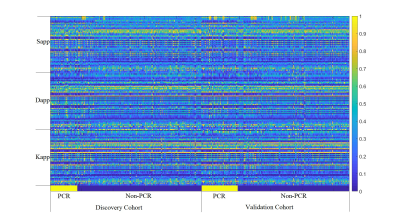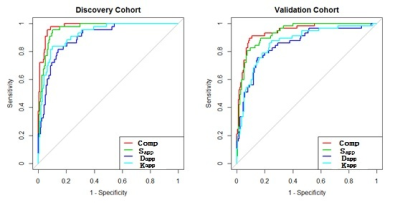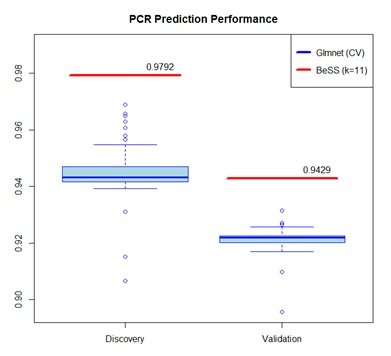3920
Prediction of pathological complete response of rectal tumor by radiomics method based on diffusion kurtosis imaging results before neoadjuvant chemoradiotherapy1Peking University Cancer Hospital, Beijing, China, 2The University of Hong Kong, Hong Kong, Hong Kong
Synopsis
Neoadjuvant chemoradiotherapy is the standard treatment for locally advanced rectal cancer. Patients with pathological complete response (pCR) after NCRT (15~21% of the total) could benefit from either less invasive surgery or a “wait-and-see” strategy. A radiomics model is proposed in this work based on diffusion kurtosis imaging (DKI) result before NCRT is used to predict pCR of rectal cancer.
Purpose
To predict pathological complete response (pCR) of locally advanced rectal cancer before neoadjuvant chemoradiotherapy (NCRT), by the combination of non-Gaussian diffusion kurtosis model (DKI) and radiomics model.Method
474 patients were averagely divided into the discovery cohort (n=240) and the validation cohort (n=234) in chronological order. Surgically resected specimens were histopathologically examined as the reference. All MRI examinations were performed with a 3.0 T MR scanner (Discovery 750; GE Healthcare) using an 8-channel phased array torso coil within one week before the initiation of NCRT. DWI data were obtained by using SSEPI with 12 b-factors (0, 20, 50, 100, 200, 400, 600, 800, 1000, 1200, 1400 and 1600 s/mm2). TR=2800 ms, TE=70 ms, FOV=340×340 mm, Matrix=256×256, thickness=4.0 mm, gap=1.0 mm. Dapp and Kapp maps were fitted by DKI fitting algorithm [1]. Beside conventional parameteric maps Dapp and Kapp, Sapp=log(S(800s/mm2)) is also used to include the structual information. The regions of interest (ROIs) of rectal tumor were manually created by radiologists on DWI slices with itk-SNAP (Fig.1). 59 quantitative imaging features were extracted from each parameteric map by homemade program on the platform of MATLAB (2011b, MathWorks). It includes 6 gray-level statistics features, 3 histogram features from 3d volumetric ROI, 3 histogram features, 8 GLCM features, 13 GLRLM features, 13 GLSZM features, 5 NGTDM features and 8 geometric features from the largest cross section. Feature selection was performed by logistic regression with best subset selection (BeSS) based on the training data defined by the discovery cohort with the BeSS package in R (R Core Team, 2017) recently developed by Wen, et al [2].Result
Predictive model is first established with 59 features from Sapp, Dapp and Kapp map individually (Fig.2). The ROC curves (Fig.3) show that Sapp model (AUC 0.963,0.934) performs better than using Dapp model (AUC 0.900, 0.852) or Kapp model (AUC 0.924, 0.864) in both discovery (first value) and validation (second value) cohorts. If the features Sapp, Dapp and Kapp are combined together (177 features), the resulting model shows improvement in both discovery (AUC=0.979) and validation cohorts (AUC=0.943). The model prediction performance by BeSS is compared with LASSO using R:glmnet package. Using the discovery cohort with 177 combined features, LASSO with cross validation selection of regularization parameter is repeated for 100 times, each time being assessed by the AUC for both discovery and validation cohorts. In Fig.4, the AUC scores from LASSO show variations among repeated runs, and their best scores are inferior to the combined model we have developed above using the BeSS method.Discussion
NCRT is the standard treatment for locally advanced rectal cancer[3]. Patients with pCR after NCRT could benefit from less invasive surgery or a “wait-and-see” strategy[4]. However, it is still a challenge to accurately predict pCR preoperatively. Recently, the predictive accuracy of pCR is further improved by non-Gaussian DKI model and radiomics model from two different approaches. But the combination of the two models are rarely studied. Previous DKI research mainly analyzed the mean value inside the tumor ROI. However, more and more studies have confirmed that the heterogeneity in the tumor is related to the biological behavior. Therefore, the combination of DKI and radiomics provide more information. For comparision, mean Dapp produces AUC=0.729 for discovery cohort and 0.770 for validation cohort and mean Kapp produces AUC=0.572 for discovery cohort and 0.695 for validation cohort. They are significantly lower than that from 59 features together. Results show that Sapp produces the highest AUC. Unlike Dapp or Kapp that only contains diffusion information, Sapp is the logarithm form of diffusion and T2 weighted image. Therefore, the combination of structral and functional information produces higher predictive power. Previous popularly used LASSO method is known to have several shortcomings in certain scenarios such that it tends to bring in a large number of unimportant features and therefore results in biased coefficient estimates[5]. To overcome such shortcomings of the lasso, the best subset selection (BeSS) approach is recommended in statistical modeling community[6], even though it has been a rather challenging problem in computation[7]. In this study we take the BeSS approach to build a logistic type of radiomics model by using the new R:BeSS package. It is justified to have superior prediction performance than the lasso method.Conclusion
We developed a DKI based radiomics model with excellent performance for individualized, non-invasive prediction of pCR. This model may be used to identify LARC patients who can omit surgery after chemoradiotherapy.Acknowledgements
No acknowledgement found.References
[1] Jensen, Jens H.; Helpern, Joseph A.MRI quantification of non-Gaussian water diffusion by kurtosis analysis. NMR IN BIOMEDICINE. 23(7):698-710.
[2] Wen, C., Zhang, A., Quan, S. and Wang, X. (2017). BeSS: an R package for best subset selection in linear, logistic and CoxPH models. arXiv: 1709.06254.
[3] Kapiteijn E, Marijnen CA, Nagtegaal ID, Putter H, Steup WH, Wiggers T, et al. Preoperative radiotherapy combined with total mesorectal excision for resectable rectal cancer. The New England journal of medicine 2001;345(9):638-46 doi 10.1056/NEJMoa010580.
[4] Maas M, Beets-Tan RGH, Lambregts DMJ, Lammering G, Nelemans PJ, Engelen SME, et al. Wait-and-See Policy for Clinical Complete Responders After Chemoradiation for Rectal Cancer. J Clin Oncol 2011;29(35):4633-40 doi 10.1200/Jco.2011.37.7176.
[5] Zou, H. (2006). The Adaptive Lasso and Its Oracle Properties. Journal of the American Statistical Association, 2006; 101, 1418-1429.
[6] Bertsimas, D, King, A. and Mazumder, R. Best Subset Selection via a Modern Optimization Lens. Annals of Statistics 2016; 44 (2), 813-852.
[7] Nataraja, B. K. Sparse Approximate Solutions to Linear Systems. SIAM J. Comput. 1995, 24, 227-234.



